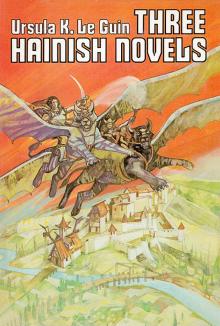- Home
- Ursula K. Le Guin
No Time to Spare Page 8
No Time to Spare Read online
Page 8
He challenges me by doing what he’s forbidden to do. And I guess there really aren’t a lot of things he’s forbidden, besides jumping up on the mantel and knocking off the kachinas.
He isn’t allowed to get on the dining table, but there’s nothing to do there but leave footprints. The mantel, which is a really big jump even for Pard, is the only unprotected display place left in the house for small ornamental things; all the others have found safe havens unreachable even by airborne cats. So jumping up onto the mantel has become his goal, his challenge.
But only if I am in the room.
He’ll spend all day in the living room and never look at the fireplace until I come in. A while after we’ve both been there, Pard begins to glance at the mantelpiece. His eyes get rounder and blacker. He wanders carelessly about on a chair arm (allowed) or side table (allowed) near the fireplace. He stands up on his hind legs to sniff a lampshade or the top of the fire screen very thoroughly with enormous interest, always a little closer to the mantelpiece. Till, usually when I’m not looking but not quite not looking, he’s airborne, and up on the mantel knocking something off. Then scolding, shouting, flight, pursuit, etc.—Trouble! Mission accomplished.
Recently there is an added element: the squirt bottle. As soon as he looks at the mantel I pick up the squirt bottle. The first couple of times, when he made ready to jump onto the mantel and I squirted him, he was totally taken aback. He didn’t even associate the squirt with the bottle. He does now. But it merely adds a new flavor, a new spice, to the Trouble. It doesn’t keep him off the mantel.
I gave in a couple of days ago and moved all the little kachinas to a haven, leaving only the two big ones and some outstanding rocks. But this morning, while I was doing downward dog with my back turned, Pard jumped up onto the mantel and knocked off the lump of Tibetan turquoise, taking a chip out of it when it hit the hearth.
The ensuing Trouble was pretty intense, although I never could get anywhere near close enough to swat him. He knew I was mad. He has been terribly polite ever since, and inclined to fall over and wave his paws in an innocently endearing manner. He’ll go on that way till we’re all in the living room this evening and the need for Trouble arises in him again.
This little cat so deeply shaped by human expectation, the tamest cat I ever had, has a flame of absolute, willful wildness.
I’m sure some of it’s the boredom factor—a young cat with old people, an indoors cat . . . But Pard doesn’t have to be an indoors cat. He chooses to.
The cat flap is opened for him all through daylight, at his request or at our suggestion. Sometimes he goes out onto the deck, looks down into the garden, birdwatches for a few minutes, and comes back. Or he may go out and turn right around and come back. Or he may say, Oh, no, thanks, it’s very large out there, and quite cold this time of year, so I think I’ll stand here halfway out the cat flap for a while and then back back in. What he doesn’t do is stay out. When the weather warms up and we’re outside too, he will, but not enthusiastically. He’ll go out and go down and eat some of the kind of grass that makes him throw up and come back indoors and throw it up on the rug. That isn’t Trouble-making, it’s just Cat-being.
There is no moral to this story, and no conclusion. Wish me luck with the squirt bottle.
Pard and the Time Machine
May 2014
PEOPLE WHO THINK of me as a Sci-Fi Writer will not be surprised to hear that there is a Time Machine in my study. So far it hasn’t transported me among the Eloi and the Morlocks or back among the dinosaurs. Fine with me. I’ll take the time I got, thanks. All my Time Machine does is save stuff from my computer and provide interest and occupation to my cat.
In Pard’s first year with us he spent a lot of time on beetles, because we had a lot of them. The box elder beetle is now endemic in Portland, having shifted its allegiance from box elders, which we don’t have, to big-leaf maples, which we have lots of. And so we have beetles, who live under the siding boards of the house and breed, and swarm, and creep and seep impossibly through nonexistent crevices of the window frames into the house, where they mass on sunlit windows and blunder about infuriatingly, getting under pillows and papers and feet, and into everything, including cups of tea and Charles’s ears. Mostly they crawl, but they fly when alarmed. They are rather pretty little beetles, and harmless, but intolerable, because (like us) there are too many of them for their own good.
Pard used to see them as animated kibbles and enjoyed the chase, the pounce, the crunch. But evidently they weren’t as tasty as Meow Mix or dental Greenies, and anyhow, enough beetles is enough. He now ignores them as steadfastly as we do, or try to.
But back then, when the Time Machine made its little clicky-whirry-insectlike internal noises, he was sure that it contained or concealed beetles, and spent a good deal of time trying to get inside it. It is 7.5 inches square and 1.5 inches high, white plastic, fortunately very tough white plastic, well and tightly sealed all round, and quite heavy for its size. All his efforts barely scratched the surface. As it continued to resist him, and his interest in beetles cooled, he stopped trying to open the Time Machine. He discovered that it offered other possibilities.
Its normal temperature is high, quite warm to the hand (and I think it gets hotter when performing its secret and mysterious connective operations in putative virtuality or the clouds of Unknowing or wherever it is it saves stuff).
My study, being half windows, is drafty and sometimes pretty cold in winter. As he came out of airborne youth and began to spend more time lying around near me in the study, Pard, being a cat, found the Warm Place.
He’s there right now, although today, the last of April, my thermometer says it’s 77 degrees and rising. He is sound asleep. About one fifth of him is right on top of the Time Machine. The rest of him, paws and so on, spills over to the desk top, partly onto a lovely soft alpaca Moebius scarf a kind reader sent me with a prescient note that said, “If you don’t need this I hope your cat will like it,” and partly on a little wool fetish-bear mat from the Southwest that a friend gave me. I never had a chance at the scarf. I opened the package at my desk. Pard came over and appropriated the scarf without a word. He dragged it a few inches away from me, lay down on it, and began to knead it, looking dreamy and purring softly, till he went to sleep. It was his scarf. The mat arrived later, and was adopted as promptly: he sat on it. The cat sat on the mat. His mat. No argument. So the mat and scarf lie on the desk right by the warm Time Machine, and the cat distributes himself daily among the three of them, and purrs, and sleeps.
The other use he may have found for the Time Machine is purely, to me, speculative. It involves dematerialization.
Pard doesn’t go outside often or stay long unless one of us is with him. He can’t sleep outside, can barely lie down and half relax; he remains stimulated, watchful, jumpy. He has Indoors and those who share it with him pretty well under his paw, but he knows that Outdoors is way beyond his knowledge or control. He’s not at home there. Wise little cat. So when now and then he vanishes, I don’t much worry about his having somehow got out the back door and then found his cat flap locked; he’s somewhere about the house.
But sometimes the disappearance goes on, and there is no Pard anywhere, outside or in. He is not in the basement, or the dark attic, or in a closet or a cupboard, or under a bedspread. He is not. He has dematerialized.
I get anxious and call his food call, ticky-ticky-ticky! and rattle the can of Greenies in an alluring fashion that would ordinarily bring him straight up or down the stairs without touching paw to stair.
Silence. Absence. No cat.
I tell myself to stop fretting, and Charles tells me to stop fretting, and I attempt or pretend to stop fretting, and go on with whatever I’m doing, fretting.
The sense of mystery is constant and oppressive.
And then, there he is. He has rematerialized before my eyes. There he is, with his tail curved over his back, and a bland, friendly expression suggestin
g permanent readiness for Food.
Pard, where were you?
Silence. Affable presence. Mystery.
I think he uses the Time Machine. I think it takes him elsewhere. Not cyberspace, that’s no place for cats. Maybe he uses it to open temporal interstices, like the impossible window-frame nonspaces by which box elder beetles enter the house. By such secret ways, known to Bastet and Li Shou, lit by the stars of Leo, he visits that mysterious realm, that greater outdoors, where he is safe and perfectly at home.
Part Three
* * *
Trying to Make Sense of It
A Band of Brothers, a Stream of Sisters
November 2010
I HAVE COME to see male group solidarity as an immensely powerful force in human affairs, more powerful, perhaps, than the feminism of the late twentieth century took into account.
It’s amazing, given their different physiology and complement of hormones, how much alike men and women are in most ways. Still it seems to be the fact that women on the whole have less direct competitive drive and desire to dominate, and therefore, paradoxically, have less need to bond with one another in ranked, exclusive groups.
The power of male group solidarity must come from the control and channeling of male rivalry, the repression and concentration of the hormone-driven will to dominate that so often dominates men themselves. It is a remarkable reversal. The destructive, anarchic energy of individual rivalry and competitive ambition is diverted into loyalty to group and leader and directed to more or less constructive social enterprise.
Such groups are closed, positing “the other” as outsider. They exclude, first, women; then, men of a different age, or kind, or caste, or nation, or level of achievement, etc.—exclusions that reinforce the solidarity and power of the excluders. Perceiving any threat, the “band of brothers” joins together to present an impermeable front.
Male solidarity appears to me to have been the prime shaper of most of the great ancient institutions of society—Government, Army, Priesthood, University, and the new one that may be devouring all the others, Corporation. The existence and dominance of these hierarchic, organized, coherent, durable institutions goes back so far and has been so nearly universal that it’s mostly just called “how things are,” “the world,” “the division of labor,” “history,” “God’s will,” etc.
As for female solidarity, without it human society, I think, would not exist. But it remains all but invisible to men, history, and God.
Female solidarity might better be called fluidity—a stream or river rather than a structure. The only institutions I am fairly sure it has played some part in shaping are the tribe and that very amorphous thing, the family. Wherever the male arrangement of society permits the fellowship of women on their own terms, it tends to be casual, unformulated, unhierarchical; to be ad hoc rather than fixed, flexible rather than rigid, and more collaborative than competitive. That it has mostly operated in the private rather than the public sphere is a function of the male control of society, the male definition and separation of “public” and “private.” It’s hard to know if women’s groups would ever gather into great centers, because the relentless pressure from male institutions against such aggregation has prevented it. It might not happen anyhow. Instead of rising from the rigorous control of aggression in the pursuit of power, the energy of female solidarity comes from the wish and need for mutual aid and, often, the search for freedom from oppression. Elusiveness is the essence of fluidity.
So when the interdependence of women is perceived as a threat to the dependence of women on men and the childbearing, child-rearing, family-serving, man-serving role assigned to women, it’s easy to declare that it simply doesn’t exist. Women have no loyalty, do not understand what friendship is, etc. Denial is an effective weapon in the hands of fear. The idea of female independence and interdependence is met with scoffing hatred by both men and women who see themselves as benefiting from male dominance. Misogyny is by no means limited to men. Living in “a man’s world,” plenty of women distrust and fear themselves as much or more than men do.
Insofar as the feminism of the 1970s played on fear, exalting the independence and interdependence of women, it was playing with fire. We cried “Sisterhood is powerful!”—and they believed us. Terrified misogynists of both sexes were howling that the house was burning down before most feminists found out where the matches were.
The nature of sisterhood is so utterly different from the power of brotherhood that it’s hard to predict how it might change society. In any case, we’ve seen only a glimpse of what its effects might be.
The great ancient male institutions have been increasingly infiltrated by women for the last two centuries, and this is a very great change. But when women manage to join the institutions that excluded them, they mostly end up being co-opted by them, serving male ends, enforcing male values.
Which is why I have a problem with women in combat in the armed services, and why I watch the rise of women in the “great” universities and the corporations—even the government—with an anxious eye.
Can women operate as women in a male institution without becoming imitation men?
If so, will they change the institution so radically that the men are likely to label it second-class, lower the pay, and abandon it? This has happened to some extent in several fields, such as the practice of teaching and medicine, increasingly in the hands of women. But the management of those fields, the power and the definition of their aims, still belongs to men. The question remains open.
As I look back on the feminism of the late twentieth century, I see it as typical of feminine solidarity—all Indians, no chiefs. It was an attempt to create an unhierarchical, inclusive, flexible, collaborative, unstructured, ad hoc body of people to bring the genders together in a better balance.
Women who want to work toward that end need, I think, to recognize and respect their own elusive, invaluable, indestructible kind of solidarity—as do men. And they need to recognize both the great value of male solidarity and the inferiority of gender solidarity to human solidarity—as do men.
I think feminism continues and will continue to exist wherever women work in their own way with one another and with men, and wherever women and men go on questioning male definitions of value, refusing gender exclusivity, affirming interdependence, distrusting aggression, seeking freedom always.
Exorcists
November 2010
THE ROMAN CATHOLIC bishops of the United States are holding a conference on exorcism in Baltimore today and tomorrow. Many bishops and sixty priests are there to learn the symptoms of demonic possession—you may be possessed if you exhibit unusual strength, talk in a language you don’t know, or react violently to anything holy—and the rites of exorcism, which include sprinkling holy water on you, laying hands on you, recitations, invocations, and blowing in your face.
The church updated the rite in 1999, advising that “all must be done to avoid the perception that exorcism is magic or superstition.” This seems rather like issuing directions for driving a car while cautioning that all must be done to avoid the perception that a moving vehicle is being guided.
I’d advise weightlifters and people learning a foreign language to avoid Baltimore this weekend. I don’t know how to advise people who react violently to anything holy. I don’t know who they are, because I don’t know what kind of violent reaction is meant, and because “what is holy” depends entirely on your perception of sacredness. If I am shaken by unutterably strong emotion when I watch a pair of eagles dance with each other on the wind, or when I hear the first notes of the theme of the last movement of the Ninth Symphony, am I possessed by a demon? I don’t know, but I’m staying away from Baltimore.
I think the people who should hurry there are the four male Catholic judges of the United States Supreme Court, all of whom are adherents of the policies of Pope Ratzinger and members of the ultra-reactionary Catholic group Opus Dei. Exorcism lessons shoul
d enrich their repertory no end. The fifth Roman Catholic on the Supreme Court is a woman, and thereby excluded from doing the “work of God.”
Uniforms
February 2011
THE UNITED STATES went to war with Germany and Japan when I was a kid of eleven. One of the things I remember is how—overnight, it seemed to me—the streets of Berkeley filled up with uniforms. All during the war, men in civvies were in the minority downtown. But the uniforms didn’t bring uniformity into the city. If anything, they were an improvement on the drab, same-old clothing of the end of the Great Depression.
The army and army air force wore khaki in various shades of brown, greenish, and tan: handsome jackets, creased pants, shined black shoes, all very trim. But never quite a match for the navy uniforms, the gobs in their white tunics and pants and little round white hats in summer, and in winter, blue wool tunics with a sailor collar and pants with a thirteen-button, square flap fly, I kid you not. Cute little round butts looked terrific in that uniform. And the officers in their crisp white or navy blue, gold buttons, gold braid, were a breed apart, sharp as tacks. There were no Marine bases near Berkeley that I know of; anyway we didn’t see Marines around much, but they looked quite grand in the newsreels.
My brother Clif’s ship was commissioned in San Francisco Harbor and we went to the ceremony: a fine show, formal, traditional, embellished by those dandy dress uniforms. The men looked terrific lined up there on the deck, all blue and white and gold in the sun. What boy wouldn’t want to look like that, and be seen looking like that by everybody?
A uniform, ever since the eighteenth century, when they first really started inventing them, has been known as a powerful aid to recruitment.

 Catwings
Catwings Tehanu
Tehanu The Tombs of Atuan
The Tombs of Atuan A Wizard of Earthsea
A Wizard of Earthsea The Other Wind
The Other Wind Ursula K. Le Guin
Ursula K. Le Guin Dangerous People
Dangerous People Worlds of Exile and Illusion: Rocannon's World, Planet of Exile, City of Illusions
Worlds of Exile and Illusion: Rocannon's World, Planet of Exile, City of Illusions Three Hainish Novels
Three Hainish Novels The Left Hand Of Darkness (SF Masterworks)
The Left Hand Of Darkness (SF Masterworks) The Unreal and the Real - Vol 1 - Where On Earth
The Unreal and the Real - Vol 1 - Where On Earth The Visionary
The Visionary The Ones Who Walk Away from Omelas
The Ones Who Walk Away from Omelas The Word for World is Forest
The Word for World is Forest Always Coming Home
Always Coming Home The Unreal and the Real - Vol 2 - Outer Space, Inner Lands
The Unreal and the Real - Vol 2 - Outer Space, Inner Lands Malafrena
Malafrena The Lathe of Heaven
The Lathe of Heaven Five Ways to Forgiveness
Five Ways to Forgiveness The Eye of the Heron
The Eye of the Heron Four Ways to Forgiveness
Four Ways to Forgiveness Powers
Powers Dancing at the Edge of the World
Dancing at the Edge of the World Very Far Away from Anywhere Else
Very Far Away from Anywhere Else Voices aotws-2
Voices aotws-2 The New Atlantis
The New Atlantis The Unreal and the Real, Selected Stories of Ursula K. Le Guin Volume 1: Where on Earth
The Unreal and the Real, Selected Stories of Ursula K. Le Guin Volume 1: Where on Earth The Telling
The Telling Tehanu (Earthsea Cycle)
Tehanu (Earthsea Cycle) Nine Lives twtq-9
Nine Lives twtq-9 The Birthday of the World and Other Stories
The Birthday of the World and Other Stories The Dispossessed
The Dispossessed Changing Planes
Changing Planes Words Are My Matter
Words Are My Matter Powers aotws-3
Powers aotws-3 Lavinia
Lavinia The Wind's Twelve Quarters
The Wind's Twelve Quarters Orsinian Tales
Orsinian Tales Gifts aotws-1
Gifts aotws-1 Coming of Age in Karhide
Coming of Age in Karhide The Books of Earthsea: The Complete Illustrated Edition
The Books of Earthsea: The Complete Illustrated Edition The Found and the Lost
The Found and the Lost No Time to Spare
No Time to Spare Voices
Voices The Wild Girls
The Wild Girls Old Music and the Slave Women
Old Music and the Slave Women The Daughter of Odren
The Daughter of Odren A Fisherman of the Inland Sea: Stories
A Fisherman of the Inland Sea: Stories A Wizard of Earthsea (The Earthsea Cycle)
A Wizard of Earthsea (The Earthsea Cycle) The Beginning Place
The Beginning Place The Left Hand of Darkness
The Left Hand of Darkness The Farthest Shore (Earthsea Cycle)
The Farthest Shore (Earthsea Cycle) The Matter of Seggri botw-2
The Matter of Seggri botw-2